
The European market potential for canned fruits and vegetables
In the long term, the European market for canned fruits and vegetables is expected to grow around 1–2% per year. Products face significant competition from similar ones in the fresh and frozen market, as well as from dried fruit and vegetables. As consumers move away from sweetened products, one important trend is consumer preference for canned fruits soaked in their own natural fruit juices or in light syrup instead of standard sugar syrup. Germany, the United Kingdom, France, the Netherlands, Spain and Belgium offer opportunities for exporters from developing countries.
processed-fruit-vegetables-edible-nuts/canned-fruit-vegetables/
Contents of this page
1. Product description
Canned fruits and vegetables are made using various fruits and vegetables that are processed and preserved by being sealed in airtight containers, typically cans, and then heat sterilised. This method ensures a long shelf life while maintaining a significant amount of the original nutritional value. These products are processed by various techniques, such as peeling, chopping and cooking, and then sealed in air-tight tins or aluminium cans.
Canned fruits and vegetables are defined as products that meet the following descriptions:
- Prepared from sound fruits and vegetables, fresh, frozen, thermally processed or processed by other physical methods, having reached appropriate maturity for processing;
- Packed with or without a suitable liquid packing medium;
- Vacuum packaged with a packing medium that does not exceed 20% of the product’s net weight;
- Processed by heat or in an appropriate manner, before or after being hermetically sealed in a container so as to prevent spoilage, including during normal storage.
Popular canned fruit products include peaches, pears, pineapples, cherries and various types of berries. These are often canned in their own juice, syrup or water. The appeal of canned fruits lies in their convenience, year-round availability and long shelf life. They are used in a variety of culinary applications, from baking and desserts to cocktails and salads.
Canned vegetables, on the other hand, include a wide array of products like tomatoes, corn, peas, beans, carrots and mixed vegetables. They are typically canned using water, brine or a sauce. A major selling point is their convenience, as they are pre-cooked and ready to use. Canned vegetables are staples in households and the food service industry, used in everything from soups and stews to side dishes.
Figure 1: Supermarket aisle with canned fruit and vegetable products
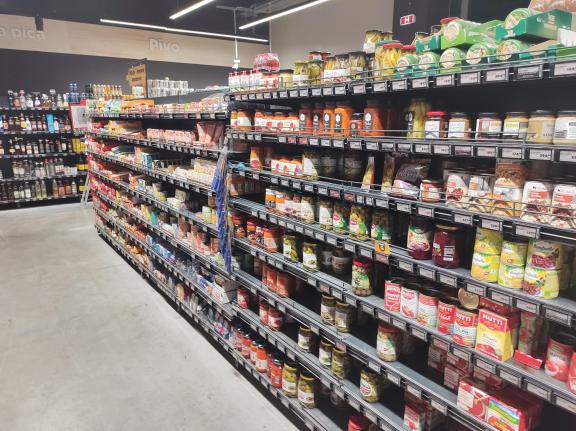
Source: Autentika Global
This study covers general information regarding the overall market for canned fruits and vegetables in Europe for producers in developing countries. In this study, the term ‘Europe’ refers to the 27 member states of the European Union (EU), plus the United Kingdom (UK) and the EFTA countries (Iceland, Liechtenstein, Norway and Switzerland). Please see Table 1 for the product groups and their codes.
Table 1: Canned fruit and vegetable product groups
| Harmonized system (HS) codes (and corresponding Combined Nomenclature 6-digit codes) | Products |
|---|---|
| 2001 (200110, 200120 and 200190) | Cucumbers, onions, and vegetables prepared or preserved by vinegar or acetic acid |
| 2002 (200210, 200290) | Prepared or preserved tomatoes |
| 2003 (200310, 200320, 200390) | Mushrooms prepared or preserved otherwise than by vinegar or acetic acid |
| 2005 (200510-200599) | Fruit and vegetables prepared or preserved otherwise than by vinegar or acetic acid |
| 2008 (200820-200899) | Prepared or preserved pineapples, citrus fruit, pears, apricots, cherries, peaches, strawberries, palm hearts, fruit mixtures, cranberries, lingonberries and other fruit |
2. What makes Europe an interesting market for canned fruits and vegetables?
Traditionally, European consumers are very familiar with canned fruit and vegetable products and their consumption. Europe’s market for canned fruits and vegetables also presents several important attractions for potential exporters and producers. The European canned fruits and vegetables market has shown consecutive years of growth in sales value. This trend suggests solid demand and a large consumer base for canned products.
Furthermore, there has been a significant shift towards healthier eating habits, leading to higher consumption of fruits and vegetables in Europe. Canned products, which offer convenience and year-round availability, align well with these trends. This is especially true for consumers who want quick and easy meal options that do not compromise on nutritional value. Europe’s need for a steady supply of fruit and vegetables is persistent, as consumers must meet their dietary needs even in times of crisis.
Figure 2: Typical home pantry with canned fruit and vegetable products
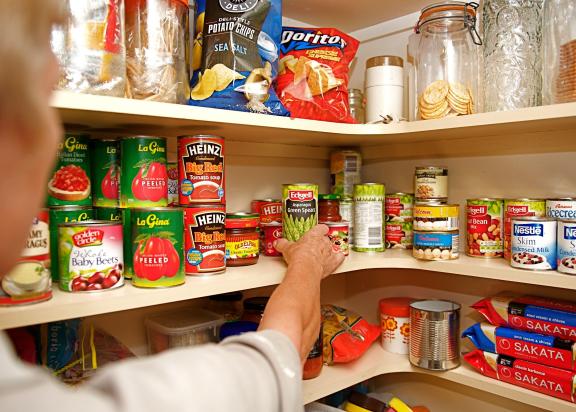
Source: ‘Canned’ by Geoff Penaluna, licensed under CC BY 2.0
Europe accounts for over 70% of the world’s total imports, although this also includes intra-European trade. European imports of canned fruits and vegetables increased in terms of value by 8.6% on average per year over the 2018–2022 period. Volume growth is lower, as the value of imports has risen primarily because of higher prices. Almost 80% of imports that arrive from outside Europe come from developing countries. The term ‘developing countries’ is used in this report to denote countries listed on the OECD-DAC list of ODA recipients for 2024 and 2025 flows (PDF). The annual growth rate is expressed as the cumulative annual growth rate (CAGR).
Over the next 5 years, the European market for canned fruits and vegetables is likely to increase at an annual growth rate of 3–4% (in terms of value). This increase in imported value is driven by a combination of factors. These include inflationary tendencies, the increasing popularity of prepared food products, healthy snacking trends and advancements in canning technology. The increase in volume imports is likely to be less pronounced due to competition from other food types (for example, frozen foods). Shorter changes in imports may be related to crop volumes and prices.
Source: Autentika Global, GTA, *canned fruits and vegetables from Table 1, 2024
Internal European trade accounts for almost 75% of all imports of canned fruits and vegetables. It predominantly involves the supply of canned tomatoes from Italy, but canned products from other important European suppliers, such as Spain, the Netherlands, Belgium and Greece, are also significant.
Fluctuations in imports of certain canned products are often caused by the size and quality of the harvested raw materials rather than by structural changes in the market. This means significant competition for new developing country suppliers if they focus on the most traded goods, which include canned tomatoes and canned mushrooms.
Source: Autentika Global, GTA, 2024, *canned fruits and vegetables from Table 1, 2024
One attractive aspect of the market is the expanding distribution network for canned food items in Europe, which includes online and offline shops dedicated to niche and specialty food markets, such as Asian, vegan and organic stores. This can contribute to market growth.
Tips:
- Consult the latest news and publications about the European market for processed fruit and vegetables, published by PROFEL, the European Association of Fruit and Vegetable Processing Industries. The PROFEL website provides links to its members’ websites.
- Explore specific opportunities in the canned bean market, for example, see our study about exporting canned beans to Europe.
3. Which European countries offer the most opportunities for canned fruits and vegetables?
The largest importing and consuming countries are Germany, France, the UK, the Netherlands, Belgium and Spain. As Europe’s largest food market, Germany is an interesting focus market for exports. Germany also provides specific opportunities for organically certified canned fruits and vegetables, as it is the leading organic market in Europe. The UK and France follow closely as they have relatively lower production than Spain and Italy. The Netherlands is a major market for canned fruits and vegetables as it also re-exports these products.
Germany: The leading European market for canned fruits and vegetables
Germany is Europe’s main importer of canned fruits and vegetables. Germany’s import volume of canned fruits and vegetables was 1.86 million tonnes in 2022. Imports have increased consistently from year to year, although there was a slight dip in imports in 2021. The average growth was slightly positive at 2.4%. In value terms, German imports increased by 9% on average, reaching €2.89 billion in 2022, which is €1 billion more than France.
The top 3 products by volume, imported by Germany, come from within Europe. First place is taken by canned preserved and whole tomatoes (mostly from Italy), which jointly account for more than 25% of imports. Imports of canned vegetables and vegetable mixtures follow, with around 10% of the overall imported volume. Imports of non-frozen canned potatoes total 7%.
Figure 5: Canned peach halves sold by Germany’s discount chain Lidl
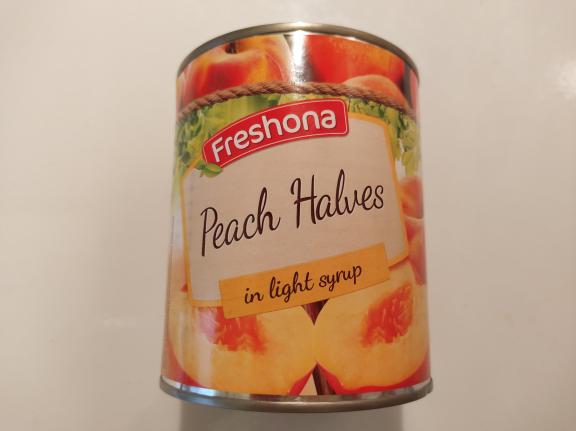
Source: Autentika Global
The top 3 products imported from developing countries are:
- Canned pickled vegetables, predominantly from Türkiye and China, but also from Thailand, India, Indonesia, South Africa, Peru and Mexico;
- Canned olives, mostly from Türkiye, followed by Morocco and Egypt;
- Canned pineapple, imported from Indonesia, Thailand, the Philippines, Kenya, Sri Lanka and Vietnam.
Germany is also the leading market for organic products in Europe, with a revenue of €15.9 billion in 2021. The country is one of the most important markets for organic products globally according to a 2023 Blumberg market analysis of the organic food market in Germany (PDF).
Due to the increasingly busy lifestyle of consumers, there is increasing demand for products that are easy to consume and to prepare. Consumers often purchase canned fruits and vegetables in supermarkets and convenience stores. Canned tomato puree, pastes and pickled vegetables are popular in Germany as they can be used in a variety of recipes.
Consumer demand for canned fruits is shifting towards the frozen segment. One reason for this is because the canned industry has been plagued by higher metal costs for tins. One visible trend is that industrial clients have been using more frozen fruit.
In 2021, Germany accounted for around 25% of the total volume of canned bean products imported into Europe. Germany’s climatic conditions limit the types of fruit and vegetables that can be cultivated domestically. This means canned fruits and vegetables are an important part of consumer nutrition. Popular canned products include beetroot, pears, peaches and sauerkraut.
Tips:
- Talk to traders, raw material bundlers and suppliers in Germany’s organic market. A good way to make contacts is to participate in relevant food trade fairs, such as Anuga in Cologne, Biofach in Nuremberg, and Fruit Logistica in Berlin.
- Keep an eye on news from Germany’s organic farming associations, such as Bioland (in German), Naturland and Demeter (in German), as they help shape the national agricultural policy landscape. You can use Google Translate to translate German into your language.
United Kingdom: A market where canned is making a comeback
The United Kingdom (UK) imports considerably fewer canned fruits and vegetables than Germany. Imported volumes rose at a rate of 4.4% per year between 2018 and 2022, reaching 1.17 million tonnes in 2022. In the same time period, the value of imports increased by 12.2% annually, reaching €1.89 billion in 2022.
The UK is going through a relative ‘canned food renaissance’ as British consumers seek to tackle the growing pressures of the cost-of-living crisis. Sales of canned goods have been outperforming the rest of the grocery market according to a recent update from UK-based Princes Group. Surveys show that UK sales volumes of canned tomatoes have reached their highest levels since 2018. The Prince’s survey also revealed that 31% of British consumers intend to buy more canned products.
The reasons for this revival of canned goods mainly relate to lower costs and longer shelf lives. Canned fruits and vegetables are gaining popularity in consumer perception compared to rival products. Around 20% of UK consumers expect to buy less chilled foods over the coming year. The British canned industry has even launched recipe websites like Canned Food Recipes to help consumers find the perfect canned food recipes.
It is important to keep in mind that canned food’s positive value performance has been heavily affected by price inflation. Although food prices are still going up, inflation is gradually slowing in the UK. Year-on-year food prices rose by 7% in January 2024, whereas in December, food prices had increased by 8%. This was the smallest price increase since April 2022, according to cost of living data from the Office for National Statistics (ONS).
The annual increase in the price of canned fruits and vegetables was 13% as of January 2024. Over the course of 2023, canned pickles saw the largest increase in price: 18%. To get a better sense of the latest inflationary trends in the canned food market segment in the UK, check out the prices of canned fruits and vegetables in the UK consumer prices basket in Table 2.
Table 2: Average prices of canned fruits and vegetables in the UK and their annual growth rate
| Name (weight or size) | Average price January 2024 (GBP) | Average price January 2023 (GBP) | Annual growth |
| Canned sweetcorn 198–340g | 1.04 | 0.91 | 14% |
| Canned fruit 400–450g | 1.15 | 1.07 | 7% |
| Baked beans 400–425g | 1.06 | 0.97 | 9% |
| Canned tomatoes 390–400g | 0.68 | 0.62 | 9% |
| Vegetable pickle 280–520g | 1.88 | 1.59 | 18% |
Source: ONS, 2024
Volume declines most likely indicate a return to normality rather than a decrease in demand, following a huge increase during lockdowns. Total sales of canned fruit in the UK amounted to 118.7 million GBP in the 12 months ending 9 September 2023. This represents an annual increase of 1.8%. Own label canned fruit sales accounted for 41% of the market. Retail volume sales in the same period declined 7.5%, according to an annual market survey by The Grocer. Top brands by sales include Del Monte, Nature’s Finest, Princes, Opies and Dole.
Total sales of canned vegetables (excluding baked beans) in the UK amounted to 487.5 million GBP in the 12 months ending 9 September 2023. This represents an annual increase of 12.2%. Own label canned vegetables sales accounted for 56% of the market. Retail volume sales in the same period declined 4.9%, according to the same survey. Top brands by sales include Napolina, Green Giant, Cirio, Mutti and Batchelors.
The UK market offers a lot of potential for exporters of canned vegetables aimed at Asian cuisine. According to the 2021 UK census, 9.3% of the population identified as Asian British in England and Wales. People from Asian ethnic groups made up the second largest percentage of the population in the country. The survey shows that 3.1% of the population identifies as Indian, 2.7% as Pakistani and 1.6% as Asian other. Many European supermarkets now offer canned Asian-style vegetable products.
Figure 6: Canned Asian-style vegetables in European supermarkets
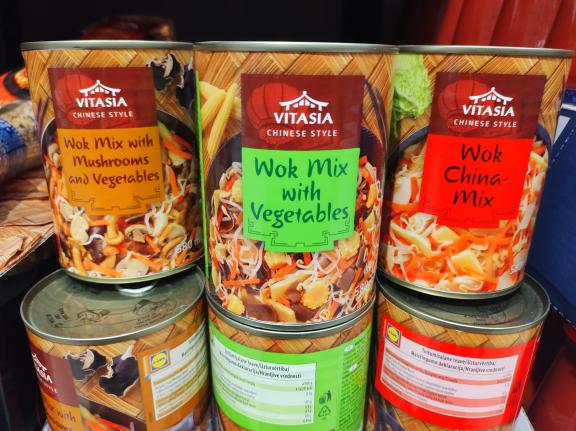
Source: Autentika Global
The top 4 canned products imported by the UK come from within Europe. Canned tomatoes are the most imported, trailed at a significant distance by canned beans, canned sweetcorn and canned pickled vegetables.
The top 3 canned products imported from developing countries are:
- Canned pineapple, with most arriving from Indonesia, followed by Thailand, Kenya, the Philippines and Vietnam;
- Canned (unspecified, often mixed) vegetables, from Türkiye, with further imports from China, India and Egypt. One of the most popular items imported from Türkiye is jarred roasted sweet peppers. Different types of pickled mixes are also popular;
- Canned citrus and mandarins that come mostly from Türkiye, China, South Africa and Eswatini.
Tip:
- Check out news on The Grocer to keep up to date with the latest developments and launches in the UK’s canned fruit and vegetables markets.
France: An important market for organic canned fruits and vegetables
France is an interesting market for canned fruits and vegetables due to its significant imports of these products. The country is the third largest importer in Europe, with imports of more than 1.1 million tonnes in 2022. Volume imports have fallen by 0.3% annually in the past 5 years, while value imports rose by 4.5% to reach €1.82 billion in 2022.
The French market for canned fruits and vegetables is driven by traditional consumption patterns, as well as consumer trends towards healthy snacking and convenience. The market also welcomes innovations in the presentation and packaging of canned fruit and vegetable products.
Regarding canned vegetables, the French market is undergoing a push towards stronger local production according to a January 2024 Euromonitor report. However, challenges in domestic production mean that imports will continue to play a significant role. Currently, about two-thirds of canned and frozen vegetables in France are imported, with the government aiming to reduce this to 50%, a figure last seen in 2010.
In 2022, the French vegetable market witnessed a shift towards canned vegetables due to inflationary pressures. Nevertheless, inflation on canned vegetables was 18% compared to 2021. High food inflation has led consumers to choose more economical and practical meal solutions according to a report from Unilet, the French inter-professional organisation of vegetable processors and producers.
This change in consumer behaviour resulted in an increased volume and value for the canned vegetable market, surpassing pre-COVID levels. All consumer categories contributed to market growth, except for families. The demand was particularly strong for products like sweet corn, which attracted 1 million new household buyers. Demand totalled 683,000 ½ tonnes brut and a turnover of €1.3 billion in 2022, a gain of almost 9 million ½ tonnes gross from 2019. The ‘tonne 1/2 brut’ unit is used to estimate volumes of packaged processed vegetables by France’s agriculture ministry (PDF). It represents 1,000 manufacturing units or 1,000 4/4 cans. It is identical, regardless of content or container.
France’s processed food sector uses ½ tonnes gross to estimate manufacturing output for canned food. This ½ tonnes gross unit equals 1,000 manufacturing units or 4/4 boxes, regardless of content or container type. Organic produce now accounts for 19% of canned vegetables purchased by the catering sector according to the latest processed fruit and vegetable annual report (PDF) from AgriMer. Leading organic brands and outlets include Biocoop, Naturalia, La Vie Claire, Les Comptoirs de la Bio, Bio c’ Bon and NaturéO.
The top 4 products imported to France, by volume, come from European suppliers. Processed and whole canned tomatoes top the list, followed by canned vegetables and vegetables mixtures, canned olives and mushrooms.
The top 3 products imported from developing countries are:
- Canned olives, imported mostly from Morocco, but also supplied by Egypt, Türkiye and Tunisia;
- Canned beans from Kenya (roughly one-third of all canned imports), Madagascar, Cameroon and China. France is one of the largest destinations for canned beans in Europe, alongside Germany and the UK;
- Canned tomatoes that come from Türkiye, Morocco, Tunisia and other countries.
Tips:
- Consult the latest annual production and trade data (in French) for processed fruits and vegetables in France from Agrimer.
- Follow the latest news on the French processed vegetables market on Unilet’s website.
The Netherlands: An important destination for pickled vegetables
The Netherlands holds a unique position as a major importer and re-exporter of fruits and vegetables in the European Union, including canned fruits from developing countries. The Netherlands is the second-largest importer of fruits and vegetables in the EU, acting as a vital gateway for global produce.
The Netherlands is the fourth largest importer of canned fruits and vegetables in Europe, with a volume slightly above 900,000 tonnes. Imports increased by 3.1% per year between 2018 and 2022. With an import value of €1.4 billion, the country is the fourth largest European importer, well behind the second and third-ranked France and the United Kingdom. Dutch imports underwent considerable growth, 9.6% per year on average. This was mostly the result of higher prices due to recent inflation.
The top 3 products imported to the Netherlands come from within Europe. In first place are canned tomatoes, followed at a considerable distance by canned mushrooms and olives.
The top 3 products imported from developing countries are:
- Canned fruit from Costa Rica, India, Ecuador and Guatemala;
- Canned pineapple, mostly from Indonesia and the Philippines, with smaller volumes arriving from Thailand, Costa Rica, Kenya and China;
- Pickled cucumbers and gherkins from Türkiye and India.
The Netherlands has become a major trade hub for different kinds of agricultural products. As a result, various types of fresh fruit are widely available and relatively cheap in the Netherlands. These often substitute canned fruits in meals, as ‘freshness’ is appreciated. There is also a strong concentration in the food retail market, with Albert Heijn, Plus and Jumbo having relatively large market shares.
Belgium: A producing and trading country
While Belgium might not be the largest consumer of canned fruits in Europe, several factors make it an interesting market for imports from developing countries. The country boasts a central location within the EU, with excellent transport infrastructure, including major ports in Antwerp and Zeebrugge. This allows the country to act as a re-export hub. Belgium offers a promising market for canned produce suppliers from developing countries thanks to its diverse import sources, openness to new products and strategic geographic position.
Belgium imported 520,000 tonnes of canned fruits and vegetables worth €930 million in 2022. Average volume growth was 0.9%, while average value growth in the same period was 7% per year.
The top products imported to Belgium come from within Europe. They are, in first place, canned mushrooms, followed by canned tomatoes and canned vegetable mixtures.
The top 3 products imported from developing countries are:
- Preserved fruits from Costa Rica (excluding pineapple) at around 12,900 tonnes, followed by canned fruits from India and Cameroon;
- Canned pineapples from Thailand (10,200 tonnes), followed by Indonesia, Kenya, the Philippines and Costa Rica;
- Canned olives, mostly imported from Morocco (9,259 tonnes) and Türkiye (5,951 tonnes).
Spain: A major producer and a major market
Spain is an important exporter of canned fruits and vegetables within the European Union, but the country also depends on imports to a considerable extent. Spanish imports grew at an average annual rate of 0.7%, to 435,000 tonnes in 2022. On average, Spanish imports increased by 4.6% in value, reaching €758.9 million in 2022.
The top 3 Spanish imports come from within Europe. They are canned sweetcorn, canned strawberries and canned tomatoes, in that order.
The top 3 products imported from developing countries are:
- Canned vegetables, most of which come from Peru and Türkiye;
- Canned pineapple, which mostly comes from Indonesia (more than 50%), with smaller volumes from the Philippines, Kenya and Thailand;
- Canned asparagus, most of which comes from China (17,000 tonnes) and Peru (11,500 tonnes), with some smaller quantities imported from Namibia.
Tips:
- See our study on the demand for processed fruit and vegetables on the European market for more information about what makes Europe an interesting market for processed fruit and vegetables.
- Check the trade statistics for products you are interested in through ITC TradeMap or Trade Helpdesk.
4. Which trends offer opportunities or pose threats in the European canned fruits and vegetables market?
Growing demand for vegan and healthy food offers opportunities for exporters from developing countries. Consumers also increasingly prefer convenience and easy-to-prepare food, and canned foods and vegetables offer this convenience. In addition, European consumers are increasingly conscious of sustainability and ethical considerations in their purchasing decisions. There is growing demand for products produced in an environmentally friendly manner and under fair working conditions.
Sugar reduction: Canned fruits in light syrup and juice cater to health-conscious consumers
In the European market, there is a growing trend of offering canned fruits in light syrup, extra-light syrup and juice as an alternative to traditional heavy syrup. A key trend in the market is the growing preference for canned fruits soaked in their own natural fruit juices compared to syrup with added sugar.
Leading canned fruit makers like Del Monte and discounters with their private label brands provide a variety of canned fruits in different syrups, with more variations in the light syrup segment. This product variation caters to consumers who want products with potentially less sugar content than traditional canned fruits in syrup. This aligns well with the broader consumer preference for healthier food options.
The lighter the syrup, the fewer the calories it contains. Many canned fruits that are typically sold in heavy syrup are equally attractive and tasty when packed in lighter syrups according to the University of Minnesota Extension service.
Figure 7: Canned fruit products in light syrup or juice sold in Europe
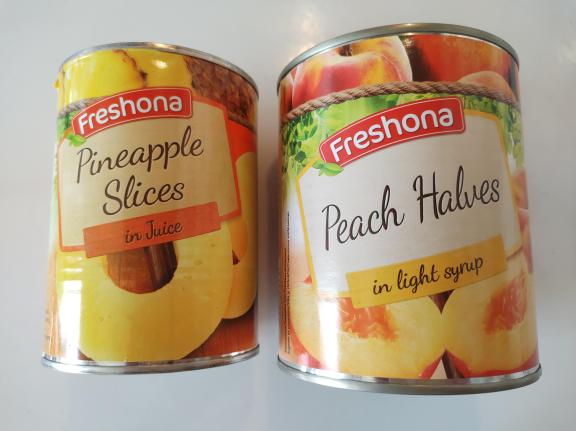
Source: Autentika Global
Montaña Azul is a family-run Costa Rican company that produces canned palm hearts, jalapeño peppers and palm ceviche. The company also produces and exports canned fruits, such as pineapple, papaya, mango, rambutan and strawberry, both in glass or canned presentations for food service and retail. The company offers recipes with light syrup, fruit juice, natural essences (for example, cloves and cinnamon) and even some canned produce with no sugar at all. The company has multiple certifications, including a social compliance audit from Elevate.
Sustainably packed products like tinned food have staying power
Recent surveys have shown that most European shoppers are displeased with the amount of plastic packaging used for products in supermarkets. This bodes well for the canned fruit and vegetable industry.
Over 87% of 2,000 surveyed consumers in the largest European markets expressed concern over the wastefulness of packaging materials. Almost 60% of consumers are especially concerned about plastic pollution and the role plastic plays in supermarkets. This is due to consumer awareness of the fact that supermarkets are instrumental in reducing plastic packaging, as supermarkets are a major source of plastic pollutants.
The survey conducted by Focaldata in November 2023 reveals that 57% of surveyed consumers across Europe are willing to pay more for products packaged in sustainable packaging. Metal packaging, with its eco-credentials, including recyclability and durability, is welcomed by 63% of respondents. Metal’s recyclability influences purchasing decisions for 82% of respondents.
A similar Eviosys-funded survey conducted a year earlier showed that more than 7 out of 10 people would not trade off on sustainability despite inflation worries. The poll showed that 40% of surveyed consumers said they would buy more food cans to help weather the cost of living crisis. Metal used in canned fruit and vegetable packaging is infinitely recyclable without any loss of quality.
Canned vegetables in glass packaging benefit from a similarly eco-friendly image. In addition to being a recyclable material, glass can also be reused without losing any of its quality. Glass is one of the few packaging materials that is infinitely recyclable according to the European Container Glass Federation (FEVE). Today, a record 78% of all container glass put on the market in Europe is collected for recycling. Furthermore, 91% of Europeans would recommend glass as the best packaging material for environmental and health reasons according to a recent FEVE report (PDF).
The glass packaging industry has made large strides to lower transport costs and cheapen the cost of packaging. The industry has strengthened glass with new surface treatments and improved designs, without sacrificing improvements made by lightweighting. Since 1985, ketchup bottles have diminished in weight by 32%.
Moving to sustainable packaging also makes good business sense. For example, the UK government remains committed to eliminating avoidable waste by 2050 and aims to recycle 65% of municipal waste by 2035. This will involve measures such as a tax on non-recycled plastic packaging. This could give a competitive edge to fruit and vegetable products packaged in sustainable, recyclable packaging, as similar trends are seen all across Europe.
To find out more about general trends, read our study about trends on the European Processed Fruit and Vegetables Market.
Tips:
- Promote the nutritional properties of your canned vegetables, especially related to protein, fibre and vitamins. However, avoid health or nutritional claims that are not substantiated by scientific evidence.
- Check the websites of European trade shows and exhibitions to discover the latest trends. The most important trade fairs in Europe relevant to frozen vegetables are SIAL (France, every even year in October), Anuga (Germany, every odd year in October) and BioFach (Germany, organic products, every year in February).
- Consider using a free carbon footprint calculator to calculate the carbon footprint of your products and to explore how you can improve your score.
Autentika Global carried out this study on behalf of CBI.
Please review our market information disclaimer.
Search
Enter search terms to find market research
